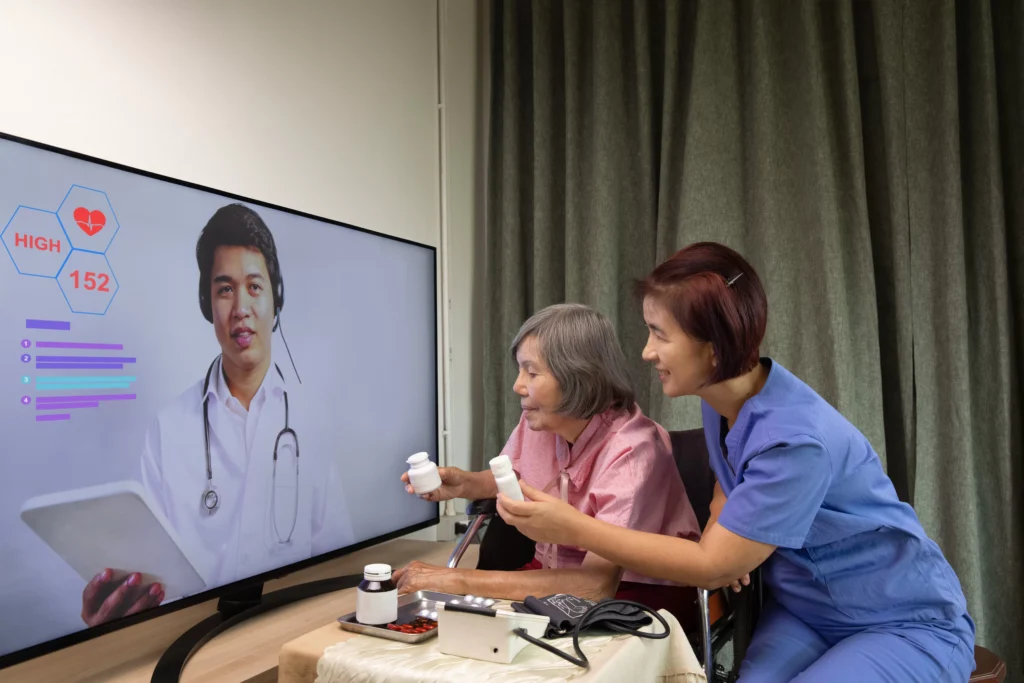The Future Of Healthcare: Embracing The Power Of Digital Health
In recent years, the healthcare industry has undergone a monumental transformation, largely driven by advancements in technology. Digital health has emerged as a revolutionary force, bringing forward innovative solutions that enhance the way healthcare services are delivered, experienced, and managed. The integration of digital health tools, from telemedicine to wearable devices, offers unprecedented opportunities to improve patient outcomes, increase access to care, and reduce the burden on healthcare systems worldwide.
As we look to the future, it’s clear that digital health will play an even more critical role in shaping the healthcare landscape. From the increasing reliance on artificial intelligence (AI) to the use of data analytics, blockchain, and mobile health apps, digital health is reshaping every aspect of how we approach patient care. In this article, we will explore the various components of digital health, its current and future implications for healthcare, and the challenges that need to be addressed as we embrace this technological revolution.
What is Digital Health?
Digital health encompasses a wide range of technologies that aim to improve healthcare delivery through the use of digital tools. These tools include electronic health records (EHR), wearable devices, mobile health apps, telemedicine, artificial intelligence (AI), and big data analytics, among others. The primary goal of digital health is to make healthcare more efficient, personalized, accessible, and cost-effective.
Digital health is not just about integrating new technology into existing healthcare practices—it represents a complete rethinking of how healthcare is provided and how patients engage with their care. Through these technological innovations, digital health allows for real-time monitoring, remote consultations, personalized treatment plans, and data-driven insights into patient outcomes. This approach is redefining the doctor-patient relationship and empowering patients to take charge of their health in ways that were once impossible.
Key Components of Digital Health
1. Telemedicine and Telehealth

Telemedicine has become one of the most prominent aspects of digital health, especially after the global COVID-19 pandemic. Telemedicine allows patients to consult with healthcare providers remotely via video calls, phone calls, or text messaging. This virtual care model offers convenience, cost-effectiveness, and increased access to healthcare, particularly for those in rural areas or with mobility issues.
Telehealth, which is a broader concept, includes telemedicine but also involves other remote services like health education, remote patient monitoring, and wellness coaching. The widespread adoption of telemedicine during the pandemic has highlighted its potential, and it’s expected that this trend will continue to grow as technology improves and regulations adapt.
2. Wearable Devices and Remote Monitoring
Wearable devices such as fitness trackers, smartwatches, and medical-grade wearables have become an integral part of digital health. These devices track vital signs like heart rate, blood pressure, oxygen levels, sleep patterns, and physical activity in real time. Wearables allow for continuous monitoring, offering patients and doctors valuable insights into health trends and potential risks.
In addition to fitness tracking, wearables are increasingly being used for chronic disease management, such as diabetes or heart disease, allowing for real-time data collection and personalized care. This data-driven approach allows healthcare providers to make informed decisions and intervene before a condition worsens.
3. Artificial Intelligence and Machine Learning

Artificial intelligence (AI) is revolutionizing healthcare by improving diagnostics, treatment recommendations, and operational efficiency. Machine learning algorithms are being used to analyze large datasets, identify patterns, and make predictions about patient health. AI-powered tools can assist in detecting conditions like cancer, heart disease, and neurological disorders earlier than traditional methods, significantly improving patient outcomes.
AI also has the potential to reduce the administrative burden on healthcare providers by automating tasks such as scheduling, billing, and medical record management. As AI continues to evolve, it will likely play an even more significant role in clinical decision-making and patient care.
4. Mobile Health (mHealth) Apps
Mobile health apps have become a staple of digital health, empowering patients to manage their health from their smartphones. These apps provide a range of services, including appointment scheduling, medication reminders, symptom tracking, mental health support, and fitness coaching. mHealth apps are also used for disease prevention, health education, and monitoring chronic conditions, making healthcare more accessible and personalized.
Many mHealth apps are also integrated with other digital health tools, such as wearables and telemedicine platforms, offering a seamless experience for patients and healthcare providers alike. As the demand for digital health solutions grows, the development of new and more sophisticated apps will continue to improve the patient experience.
5. Big Data and Analytics
Big data plays a crucial role in digital health by enabling healthcare providers to leverage vast amounts of patient data for improved decision-making. Electronic health records, patient surveys, genetic data, and other health-related information are analyzed to uncover trends, predict outcomes, and personalize treatment plans.
Data analytics also helps in public health initiatives, allowing for the identification of disease outbreaks, trends in population health, and the effectiveness of public health interventions. The ability to process and analyze large volumes of health data offers tremendous potential to improve healthcare outcomes at both the individual and population levels.
Transforming Patient Care: The Impact of Digital Health Solutions
In recent years, digital health solutions have become a transformative force in healthcare, improving patient outcomes, streamlining operations, and enhancing the overall patient experience. From mobile health apps and wearable devices to telemedicine and artificial intelligence, digital health is reshaping the way healthcare is delivered, making it more accessible, personalized, and efficient. These technological advancements not only empower healthcare providers but also put patients at the center of their care, offering them the tools to actively participate in managing their health.
This article explores the significant impact of digital health solutions on patient care, examining how they are revolutionizing healthcare delivery, improving chronic disease management, and providing a more personalized, patient-centered approach to treatment. We will also look at some of the challenges and future opportunities associated with these digital health innovations.
What is Digital Health?
Digital health refers to the use of digital technologies to monitor, manage, and improve healthcare services and patient outcomes. This includes a wide range of tools, such as electronic health records (EHR), mobile health apps, telemedicine, wearable devices, artificial intelligence (AI), big data analytics, and remote patient monitoring systems.
By leveraging these technologies, digital health aims to enhance the quality of care, reduce healthcare costs, increase access to services, and empower patients to take a more active role in managing their health. The integration of digital health solutions into everyday healthcare practices offers a more efficient, responsive, and personalized approach to patient care, which ultimately leads to better health outcomes.
Key Digital Health Solutions Impacting Patient Care
1. Telemedicine and Telehealth
Telemedicine has emerged as a game-changer in the healthcare landscape. It enables patients to consult with healthcare professionals remotely through video calls, phone calls, or messaging platforms. This technology has proven especially valuable during the COVID-19 pandemic, when physical distancing measures and lockdowns made in-person consultations challenging.
Telemedicine has brought healthcare directly into people’s homes, eliminating barriers such as long travel distances, busy schedules, and geographic isolation. In addition to providing virtual consultations, telemedicine platforms also offer remote monitoring of vital signs, follow-up appointments, and even remote prescriptions. This not only increases access to care for patients in rural or underserved areas but also reduces wait times and healthcare costs.
Telehealth is a broader concept that encompasses telemedicine, along with remote monitoring, health education, and wellness coaching. Through telehealth, patients can receive comprehensive healthcare services remotely, making it easier to manage chronic conditions, receive preventive care, and stay on top of their health needs.
2. Wearable Devices and Remote Monitoring
Wearable devices such as fitness trackers, smartwatches, and medical-grade monitors have become an integral part of the digital health revolution. These devices provide continuous, real-time data on vital signs, activity levels, and other health indicators. For example, wearable heart rate monitors, glucose meters for diabetes, and smartwatches that track sleep patterns and physical activity offer valuable insights into an individual’s health status.
Wearables allow both patients and healthcare providers to track health trends over time, detect potential health issues, and intervene early when necessary. In addition to providing real-time data, these devices can also send alerts to patients or healthcare providers if they detect abnormal readings, prompting timely interventions. This proactive approach helps prevent the worsening of conditions and promotes better chronic disease management.
For example, a diabetic patient using a continuous glucose monitor (CGM) can track their blood sugar levels throughout the day, helping them make immediate adjustments to their diet or medication. In the case of heart disease, a patient wearing a smart device that monitors heart rate and rhythm can alert their doctor to any irregularities, leading to early detection of potential cardiac events.
3. Artificial Intelligence and Machine Learning
Artificial intelligence (AI) and machine learning (ML) are revolutionizing healthcare by enhancing diagnostics, improving clinical decision-making, and streamlining operations. AI tools can analyze vast amounts of patient data, such as medical imaging, lab results, and EHRs, to detect patterns and identify health conditions earlier than traditional methods.
For instance, AI-driven systems are being used to interpret medical images (such as X-rays and MRIs) with greater accuracy, helping doctors detect diseases like cancer, cardiovascular conditions, and neurological disorders at an earlier stage. By analyzing these images quickly and efficiently, AI can help physicians make faster and more accurate diagnoses.
Machine learning algorithms are also being used to predict patient outcomes by analyzing trends in patient data. For example, AI can help predict the likelihood of a patient developing complications, allowing healthcare providers to intervene earlier and customize treatment plans based on individual risk factors.
Additionally, AI-powered virtual assistants can help streamline administrative tasks, such as scheduling, triaging patients, and managing appointments, allowing healthcare providers to focus more on patient care.
4. Mobile Health Apps (mHealth)
Mobile health apps have gained significant traction in recent years, empowering patients to take control of their health from the convenience of their smartphones. These apps serve a wide range of functions, from appointment scheduling and medication reminders to symptom tracking and mental health support.
For example, chronic disease patients can use mHealth apps to monitor and manage their conditions on a daily basis. A patient with hypertension can use an app to track their blood pressure readings, set reminders for medication, and receive educational content on managing their condition. Similarly, mental health apps provide support for individuals dealing with anxiety, depression, and stress, offering coping strategies, mindfulness exercises, and access to professional help.
Mobile health apps also promote preventive care by providing users with personalized health tips, fitness tracking, and lifestyle recommendations. By encouraging healthy behaviors and providing real-time feedback, these apps can help users stay on track with their health goals and improve their overall well-being.
5. Big Data and Predictive Analytics
Big data and predictive analytics are powerful tools that allow healthcare providers to analyze large sets of health data to uncover insights, identify trends, and predict patient outcomes. By aggregating data from various sources, such as EHRs, wearables, and clinical studies, healthcare providers can better understand the factors that contribute to disease, track treatment efficacy, and predict future health events.
Predictive analytics can also be used to identify patients at high risk of developing certain conditions, such as heart disease or diabetes, and intervene early to prevent or manage these diseases. By analyzing data on social determinants of health, lifestyle factors, and medical history, healthcare providers can offer more personalized and targeted care.
Additionally, big data is being used to improve operational efficiency in healthcare settings. By analyzing hospital data, health systems can optimize resource allocation, reduce wait times, and streamline processes, ultimately leading to better patient care.
The Impact of Digital Health Solutions on Patient Care
Digital health solutions are making a profound impact on patient care in several key areas:
1. Improved Access to Care
Digital health tools, such as telemedicine and mobile health apps, are breaking down geographical and financial barriers to care. Patients in rural or underserved areas now have access to healthcare professionals via telemedicine consultations, which would have been previously inaccessible due to distance or lack of local specialists. Additionally, patients who may face financial or mobility challenges can consult with healthcare providers from the comfort of their own homes.
2. Enhanced Patient Engagement

By providing patients with access to their health data and offering tools for self-management, digital health solutions promote greater patient engagement. Wearables, mobile health apps, and remote monitoring devices enable patients to track their progress, set health goals, and receive timely feedback from healthcare providers. This increased engagement can lead to better adherence to treatment plans and improved health outcomes.
3. Personalized Care
Digital health allows for more personalized care by offering tailored treatment plans based on individual data. With the help of AI, wearables, and predictive analytics, healthcare providers can monitor patients’ health in real time, adjust treatments as needed, and predict potential health risks before they become critical. This individualized approach ensures that patients receive the right care at the right time, improving their overall experience and health outcomes.
4. Early Detection and Prevention
Digital health tools, particularly wearables and AI-driven diagnostics, are helping healthcare providers detect health conditions at an earlier stage. Early detection allows for timely interventions, which can prevent diseases from progressing or becoming more severe. For instance, early identification of irregular heart rhythms through a wearable device can help prevent a heart attack or stroke, while AI-powered imaging systems can detect early signs of cancer that might otherwise go unnoticed.
5. Better Chronic Disease Management
Chronic disease management is one of the most significant benefits of digital health solutions. Devices such as continuous glucose monitors, blood pressure monitors, and heart rate trackers provide patients and healthcare providers with real-time data to help manage conditions like diabetes, hypertension, and cardiovascular disease. By monitoring patients continuously and adjusting treatment plans as needed, digital health helps improve disease control and reduces complications.
The Future of Digital Health: Key Trends and Predictions
As technology continues to advance, the future of digital health holds immense promise. Here are some of the key trends and predictions for the future of healthcare:
1. The Rise of Personalized Medicine
Personalized medicine is a key focus area for the future of digital health. By analyzing a patient’s genetic makeup, lifestyle, and health history, healthcare providers can tailor treatments and medications to the individual’s unique needs. This approach minimizes the trial-and-error method of treatment and improves efficacy, reducing the risk of adverse effects.
In the future, we can expect an even greater emphasis on precision medicine, where healthcare is tailored not just to individuals but also to specific populations based on genetics, environment, and social factors.
2. The Expansion of Telemedicine and Remote Care
Telemedicine will continue to expand and evolve, particularly as patients become more accustomed to receiving healthcare virtually. The rise of telemedicine has already brought major benefits, including greater convenience, faster access to specialists, and reduced healthcare costs.
The future of telemedicine will likely include more integrated services, such as virtual check-ups, remote surgeries, and even AI-driven consultations. Innovations like augmented reality (AR) and virtual reality (VR) could further enhance the telemedicine experience, enabling more immersive and interactive consultations.
3. AI and Robotics in Surgery and Diagnostics
Artificial intelligence is expected to have an even greater impact on the future of healthcare. AI-driven tools will increasingly be used in diagnostics, analyzing medical images and genetic data to identify diseases earlier and with greater accuracy. Additionally, AI-powered robotics will assist in surgeries, providing greater precision and enabling minimally invasive procedures.
With advancements in AI and machine learning, we can expect faster, more accurate diagnoses, better patient outcomes, and more cost-effective treatments.
4. Blockchain for Healthcare Data Security
As digital health relies more heavily on electronic health records and patient data, the need for robust data security becomes increasingly important. Blockchain technology has the potential to revolutionize healthcare data security by providing a decentralized, immutable ledger for storing and sharing health information.
Blockchain could offer a secure and transparent system for managing patient data, reducing the risk of data breaches and ensuring privacy and confidentiality.
5. The Growth of Virtual Health Assistants
Virtual health assistants, powered by AI, will become more widespread in the coming years. These assistants can help patients with a variety of tasks, from scheduling appointments to answering health-related questions and providing reminders for medication. Virtual assistants will enhance the patient experience by offering a more personalized, accessible, and efficient way to manage health.
Also Read: Navigating The Future: Understanding The Impact Of Healthcare Policy
Conclusion
The future of healthcare is undeniably digital, and embracing digital health innovations is key to improving patient care, increasing access to services, and reducing healthcare costs. From telemedicine and wearables to AI and big data, digital health tools have the potential to revolutionize the way we approach healthcare, making it more personalized, efficient, and accessible.
However, with these innovations come challenges such as data privacy, regulatory concerns, and the need for widespread digital literacy. To fully realize the potential of digital health, stakeholders must collaborate to address these challenges and ensure that digital health benefits all individuals, regardless of socioeconomic status or location.
The power of digital health lies in its ability to transform healthcare from a reactive system to a proactive, preventative one, putting patients at the center of their care and empowering them to take control of their health. As technology continues to evolve, so too will the possibilities for digital health, paving the way for a healthier, more connected future.
FAQs
What is digital health?
Digital health refers to the use of digital technologies such as mobile apps, telemedicine, wearables, AI, and big data analytics to improve healthcare delivery, patient outcomes, and access to care.
How does telemedicine work?
Telemedicine allows patients to consult with healthcare providers remotely via video calls, phone calls, or text messages, offering greater convenience and access to care.
What are wearables in digital health?
Wearables are devices like fitness trackers and smartwatches that monitor vital signs and health data in real time, helping patients and healthcare providers manage chronic conditions and track wellness.
What is personalized medicine?
Personalized medicine tailors healthcare treatments to the individual based on their genetics, environment, and lifestyle, offering more effective and targeted care.
How does AI improve healthcare?
AI enhances healthcare by providing faster, more accurate diagnoses, automating administrative tasks, and helping healthcare providers make better decisions using data-driven insights.
Will digital health replace traditional healthcare?
While digital health enhances and supplements traditional healthcare, it is unlikely to completely replace face-to-face interactions with healthcare providers. It will, however, transform and complement the way care is delivered.
What are the risks of digital health?
Risks include data privacy concerns, the potential for misinformation, and the digital divide, where some populations may lack access to technology. However, these risks can be mitigated through regulation, education, and technological advancements.
